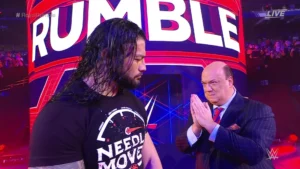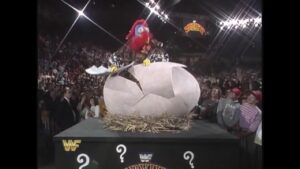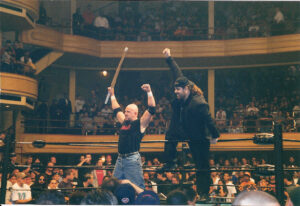The Wrestling Classic took place on this day 36 years ago. Let’s take a look back at the event and its impact on the wrestling landscape.
The year 1985 was a monumental year for the World Wrestling Federation (WWF). While the company was in the middle of its fourth decade of operation by this time (starting in 1953 as the Capitol Wrestling Corporation by Jess McMahon, then taken over by Vince McMahon Sr. Soon after, rebranded as World Wide Wrestling Federation (WWWF) in 1963, before becoming simply the WWF in 1979). The company was barely into its third year under the management and ownership of Vince McMahon Jr. Who had acquired the company from his father in 1982. But 1985 would mark the year that the WWF would emerge as the global leader in professional wrestling – er, sports entertainment – when it partnered with a burgeoning new cable network called MTV and then launched their first foray into the world of Pay-Per-View (or Closed Circuit Television as was the platform of the time) with the inaugural WrestleMania on March 31, 1985. While WrestleMania wasn’t the first wrestling SuperCard to air on PPV – Jim Crockett‘s inaugural Starrcade 1983 beat WrestleMania by a year and a half on November 24, 1983 – its lead-in and exposure via MTV helped bring the world of pro wrestling to a younger audience that had yet to experience the sport on such a major level.
But while WrestleMania is remembered as an important cultural landmark for the history of professional wrestling, whether you’re a WWE fan or not, its impact is more about what the event created than its actual card. The legacy of WrestleMania, as not only the flagship PPV event of WWE’s season annually but also the pinnacle of pro wrestling’s yearly calendar upon which multiples of promotions base events around, is without question. But apart from the main event of the evening, which saw WWF World Heavyweight Champion Hulk Hogan team up with TV star Mr. T to face the dastardly duo of Rowdy Roddy Piper and “Mr. Wonderful” Paul Orndorff, and Wendi Richter finally winning the WWF Women’s Championship. The rest of the card is mostly forgotten. It definitely had some other great moments – The U.S. Express duo of a young Barry Windham and Mike Rotunda versus The Iron Sheik & Nikolai Volkoff for the WWF World Tag Team titles. A gritty battle for the WWF Intercontinental Championship between Greg “The Hammer” Valentine and challenger Junkyard Dog, or Andre the Giant slamming Big John Studd for example. It also had some matches that in hindsight were more suited for an episode of WWF Superstars than a WrestleMania card. While rising WWF stars Tito Santana, Ricky Steamboat, and King Kong Bundy were featured on the show. They faced the respective foes of The Executioner (a masked “Playboy” Buddy Rose), S.D. “Special Delivery” Jones, and Matt Borne (pre-Doink days) – hardly classic matches that even WWF fans of the time recalled a year later, much less today. And who can forget the mat classic between Brutus Beefcake (before he decided to cut hair) and David Sammartino? (SPOILER: Everyone did).
But even still, WrestleMania proved to be the gamble that ultimately paid off for the brash young McMahon. Suddenly the WWF, which had seen a decline in national exposure in the waning years of his father’s ownership, was now more spoken about a new youth emergence in fandom that more touted brands like the National Wrestling Alliance (NWA) or American Wrestling Association (AWA). The February event, The War to Settle The Score, which aired on MTV on February 18, helped kick start the WWF as the MTV Generation’s promotion of choice. With its storylines leading directly into the first WrestleMania. Of course, after the immediate success of WrestleMania, suddenly more entertainment platforms wanted to jump on the pro wrestling bandwagon, which led to WWF’s partnership with NBC to present the first Saturday Night’s Main Event. This was taped on May 11, 1985 and aired the following night in place of Saturday Night Live. The program would be so successful, they would air two more that year. The second on October 5 and the third on November 2. Hulkamania was running wild around the world, and WWF-Mania was starting to appear all over American television. But while these TV programs were great at getting the product out to a newer, more hip audience than the days of pro wrestling in the 1970s, it was clear that the Pay-Per-View platform was going to be the future of revenue for a major pro wrestling company. Vince was preparing for his next foray into the medium.
On July 8, 1995, the WWF held its next “SuperCard”, the inaugural King of the Ring tournament. It took place at the Sullivan Stadium in Foxboro, Massachusetts (former home of the New England Patriots, demolished in 2002). The event drew 23,000 spectators for what was essentially a supercharged house show. The tournament based event, which saw Don Muraco defeat The Iron Sheik in the finals, and headlined by WWF World Champion Hulk Hogan defeating Nikolai Volkoff, was not broadcast live to the WWF Universe (the first King of the Ring to be televised live as a PPV wouldn’t occur until 1993). With the success of the event, it created a similar format for what would become the WWF’s second official offering on the PPV platform. WWF Wrestling Classic on November 7, 1985. Similar to the King of the Ring, The Wrestling Classic would feature a tournament featuring 16 WWF Superstars competing in a single knockout style. This time to be called “The King of the Hill”. While the first King of the Ring was a special fun event for the live crowd in Foxboro, this was being televised around the world. And it would become the first introduction or PPV debut for several stars who would help define the WWF and its success in the 1980s.
WWF was constantly looking to poach top stars from the myriad of territories. Whether they were a part of the NWA or the AWA. From the biggest promotions to small and more regionalized promotions – McMahon Jr. was hungry to keep his vision of the WWF stocked and he needed more than the names he had at the first WrestleMania. In June of 1985, WWF brought in former NWA World’s Heavyweight Champion Terry Funk. They still had some other young studs they’d brought in months before WrestleMania, such as British wrestlers Dynamite Kid and Davey Boy Smith. McMahon had brought in after acquiring the Stampede Wrestling territory in Calgary, Alberta, Canada (Vince had only paired the two together two weeks prior to WrestleMania at a house show in Toronto, despite both debuting in late 1984). In August of 1985, McMahon had promoted an enhancement wrestler in the WWF known as RT Reynolds to a new star based on the success of Sylvester Stallone‘s Rambo franchise. Rechristening Reynolds as Corporal Kirchner. While Funk may have been the bigger name on a national level, it was one of McMahon’s coups from the Memphis territory that would prove to be his shrewdest acquisition of 1985. A fiery second-generation grappler known as “Macho Man” Randy Savage. Savage debuted in June of 1985 with WWF and was picking up a string of victories on WWF’s syndicated programming. This was to be WWF PPV debut for the Macho Madness. Combined with some of the other younger stars who may or may not have had the greatest matches at WrestleMania, such as Ricky Steamboat, Tito Santana (who was the then reigning WWF Intercontinental Champion), Junkyard Dog, and Adrian Adonis. The latter of whom had just recently become “Adorable” and undertaking his first proper WWF singles stretch following a long stint as part of the North-South Connection with Dick Murdoch since 1983 (the duo held the WWF World Tag Team titles for 279-days from 1984 into early 1985). Adding into the mix of the tournament alongside these names were two of the WrestleMania main eventers. Paul Orndorff and Cowboy “Ace” Bob Orton Jr., as well as the Iron Sheik, Nikolai Volkoff, Moondog Spot, and the inaugural King of the Ring winner, The Magnificent Muraco. Despite being a main event star for the WWF prior to WrestleMania – including two memorable runs as an early WWF Intercontinental Champion – Muraco didn’t appear on the first WrestleMania. Leading up to his King of The Ring victory, Muraco became the #1 contender to Hulk Hogan’s WWF World title. Facing him on several occasions, including multiple main events on WWF cable shows. For the most part, it was a very strong tournament bracket of established stars in the WWF Universe as well as newer stars from other territories. And the event would also feature one non-tournament match. A WWF World Championship title defense for Hulk Hogan, against his WrestleMania foe Rowdy Roddy Piper, but this time in straight singles action.

On November 7, 1985, live from the Rosemount Horizon (now Allstate Arena) in Chicago, Illinois. In front of 14,000 WWF fans, the WWF presented their second Pay-Per-View event, The WWF Wrestling Classic. Despite a pretty solid roster for late 1985 in the WWF, every match in the “King of the Hill” tournament wasn’t an instant classic. Dynamite Kid famously defeated Nikolai Volkoff in just NINE SECONDS in the opening round (he caught Volkoff off guard after the “Russian” failed to hear the starting bell out of his standard singing of the Russian national anthem). While Terry Funk lost his own opening round match against Moondog Spot in just 27 seconds, after a brawl outside the ring backfired. In the second round, Junkyard Dog eliminated Moondog Spot in just 45 seconds after a vicious headbutt. Followed by JYD doing the 3-count himself (there was no ref in the ring yet) and the count standing. The majority of the tournament saw some tremendous action, including a match between vicious rivals Tito Santana and Magnificent Muraco. Despite Junkyard Dog eventually winning the tournament and capturing the victory of the first (and only) Wrestling Classic. The tournament was clearly built around the elevation of Randy Savage into the upper echelon of the WWF’s hierarchy. His partnership with his manager Miss Elizabeth in late August (although it was pre-taped from late July) drew attention to Savage. His run in the tournament showed WWF fans just how good this territorial star who had spent most of his last 12-years in his father’s International Championship Wrestling (IWC) and Jerry Lawler‘s Memphis-based Continental Wrestling Association (CWA). Savage defeated WWF veteran “Polish Hammer” Ivan Putski in the opening round, before facing off against Ricky Steamboat in the second round (a precursor to their legendary WrestleMania III match). Finally beating The Dynamite Kid in the semi-finals. Despite a strong showing in the final, a back body drop by JYD outside the ring onto the concrete floor left Savage unable to recover, and he was counted out.
Following The Wrestling Classic, Junkyard Dog emerged as arguably the #2 babyface in WWF. That was never necessarily a good thing in the WWF in the 1980s. With Hulk Hogan and his Hulkamaniacs firmly at the top of Olympus, JYD often served more as Hogan’s right-hand man buddy than a contender for the World title. He was in essence too big a star to be in the Intercontinental title picture but trapped under the 24-inch Python ceiling that blocked most top babyfaces in the WWF. Despite still being a massive star during the height of the Rock N’ Wrestling Era that was adored in stadiums, he was, like every other face on the WWF roster. Just an underling to “The Incredible” Hulk Hogan. He would never match the bright lights of his peak with Mid South, as the top star at the Superdome in New Orleans, Lousiana in front of 21,000 fans, just two years previous. Sadly, as his status as a top-level mid-carder without much direction became more evident. JYD’s drug use escalated and in 1988, JYD – along with Don Muraco – was fired amidst a WWF tour of Europe (reportedly for drug-related issues). The British Bulldogs (Davey Boy Smith & The Dynamite Kid) would go on to great success as a tag team in the WWF. Winning the WWF World Tag Team titles at WrestleMania II in just four months after The Wrestling Classic. In February of 1986, three months after his final loss at The Wrestling Classic, Randy Savage defeated Tito Santana for the WWF Intercontinental Championship. Savage would hold the belt for an astounding 414-days (the third-longest single reign behind The Honky Tonk Man’s 454-day reign (1987-1988) and Pedro Morales’ 425-day second reign (1981-1982)). He would finally lose to Ricky Steamboat at WrestleMania III in a rematch of their second-round encounter from The Wrestling Classic.
Sadly, while the WWF would continue its journey into more and more PPVs, adding Survivor Series in 1987, SummerSlam in 1988, and Royal Rumble in 1989 to complete “The Big Four”. The Wrestling Classic was never returned to again as a potential franchise. Instead, they returned to the King of the Ring in 1986 (which saw former NWA World’s Heavyweight Champion Harley Race win the second incarnation), and that became the tournament that WWF would ultimately be best-remembered for. For one shining night on November 7, 1985, WWF stripped down the pageantry and glitz of WrestleMania and built up several new stars around a fun night of pro wrestling. On a card that, now 36-years later, holds up better than the inaugural Showcase of the Immortals has. While The Wrestling Classic will never be able to top the massive mainstream impact that the first WrestleMania had on pro wrestling’s history, it now holds up as a far more enjoyable showcase of the best WWF had to offer in 1985.
Stay tuned to the Last Word on Pro Wrestling for more on this and other stories from around the world of wrestling, as they develop. You can always count on LWOPW to be on top of the major news in the wrestling world, as well as to provide you with analysis, previews, videos, interviews, and editorials on the wrestling world. You can check out an almost unlimited array of WWE content on the WWE Network and Peacock, including the 1985 WWF Wrestling Classic PPV.






